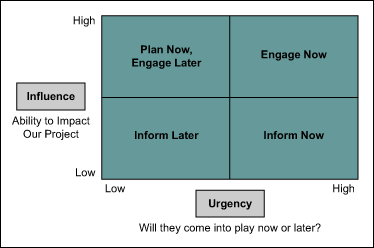
A stakeholder of a Six Sigma project is anyone associated with the project either directly or indirectly. Examples of stakeholders are supervisors providing resources, team members, department heads and employees involved in the process.
An up-front analysis of who the stakeholders are and how and when to involve them in the project can prevent potential problems. Stakeholder management:
- Prevents teams from ignoring people that are key to the project’s success
- Ensures all stakeholders understand the process and the benefits of the project
- Helps gain commitment for the project by identifying the correct influencing and communication strategy
- Helps build into the plan the actions that will win people’s support by anticipating their reaction to the project
1: Identify Stakeholders
Retrieve an initial list of stakeholders from the suppliers and customers on the SIPOC (supplier, input, process, output, customer) and use it to identify the stakeholders. Consider the sponsor, team members, employees, managers, customers, suppliers, shareholders, competitors, etc., as potential stakeholders. Write the stakeholder’s function and name in the table. If the stakeholders are a group of people (e.g., operators) consider separating them according to their stance on the project – either positive or negative (e.g., some operators might be supportive, others against the project).
2: Determine the Stakeholder’s Source of Power
Relative to the need, categorize the identified stakeholders by their source of power. For example, a stakeholder can have power because he is a decision maker, a financial and human resources expert, an opinion leader or any other important influencer.
3: Define How Each Stakeholder is Positively and/or Negatively Impacted
Determine and document how each stakeholder is affected by the project. Do not use yes or no responses, but rather describe how the stakeholder is impacted (e.g., “will benefit from cost savings” or “will have to work differently”). Defining the impact on the stakeholders will influence the communications plan.
4: Determine Stakeholder’s Current Attitude
Determine what support is necessary from the stakeholder to ensure the project’s success and what their current attitude is regarding the project. Use a simple ranking from one to five where one is “stakeholder is an opponent” and five is “stakeholder is very supportive.” Note that not every stakeholder needs to be an enthusiastic supporter for the project to succeed.
5: Develop a Communication Plan (Influence Strategy)
Review each stakeholder’s attitude assessment and understand the gap between her current attitude and the desired attitude. For each stakeholder, consider why and what to communicate, i.e., how the project might increase benefits and reduce cost or inconvenience to the stakeholder or reframe the stakeholder’s perception of the project.
Next, develop a communication strategy that focuses on how to directly or indirectly influence and engage the stakeholders. For example, a project leader might set-up regular meetings with the stakeholders, provide brief updates, see the stakeholders informally or use someone else’s help to influence the stakeholders.
Finally, determine the best time to communicate with the stakeholders and an appropriate spokesperson. Based on the influence power of a specific stakeholder and the importance of their support, create a matrix guide for the communications strategy:

6: Maintain an Updated Stakeholder Analysis and Communication Plan
Stakeholder management is a continuous process that evolves throughout the project. It is critical to review the stakeholder analysis and communication plan upon identifying a solution: Are there necessary changes or additional support required/decisions to be made/resources to be provides, etc.? Have the stakeholders’ attitudes toward the project changed? Are there new stakeholders? Adapt the stakeholder analysis according to the changes.
The stakeholder analysis and communication plan (see table below) is a six-step approach to prioritize which stakeholders to engage, how to engage them and what to communicate to them.
| Sample Stakeholder (SH) Analysis and Communication Plan | ||||||||||
| Stakeholder Analysis | Communication Planning | |||||||||
| Name | Power Source | Positive Affects | Negative Affects | Current Attitude | Desired Attitude | Objectives | Key Messages | Strategy | Start Time | Spokesman |
Conclusion
While not every project needs this kind of formalized approach to identify, analyze and plan communication with stakeholders, mobilizing the important individuals is a key factor for success for every project. Having a solution in place to improve a project is only half of what is necessary. The other half is ensuring that the stakeholders support implementing this solution and sustaining the gains far beyond the immediate project.